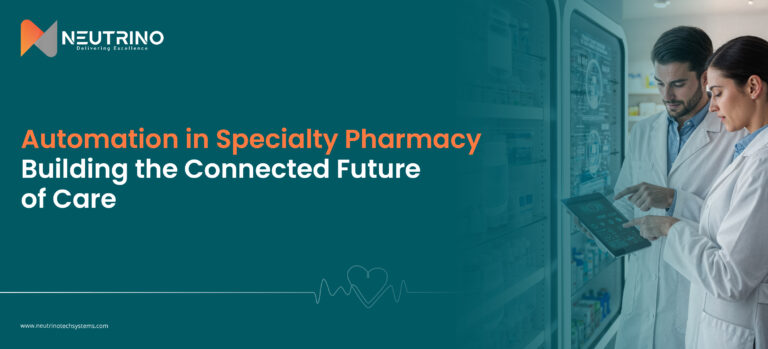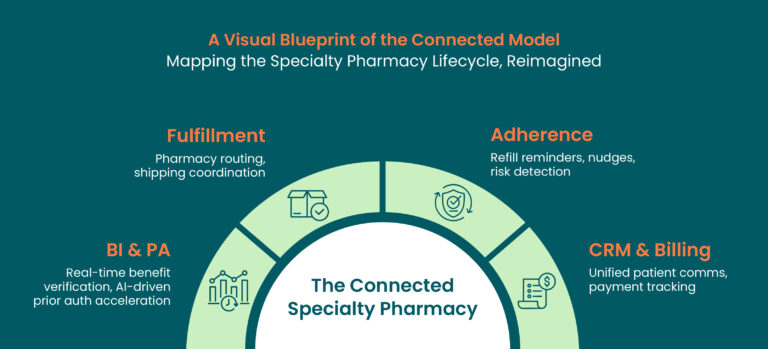Automation in Specialty Pharmacy: Building the Connected Future of Care

- August 5, 2025
Imagine being prescribed a life-saving, high-cost therapy only to be stuck in red tape. Specialty pharmacies manage high-cost, high-touch medications for complex, chronic conditions like cancer, MS, and rheumatoid arthritis. Yet the specialty journey is often fragmented: prescriptions bounce between faxes, phone calls, and siloed systems, resulting in delays, opacity, administrative fatigue, and even worse patient drop-offs. That’s why automation in specialty pharmacy isn’t a luxury but a necessity to streamline care and support timely access.
And in 2025, 94% of physicians still report care delays due to prior authorizations, a clear sign that the system remains blocked.
That’s why automation in specialty pharmacy in the US is more than a nice-to-have; it’s the lifeline we need. By weaving automation through intake, benefit checks, fulfillment, adherence, CRM, and billing, we can transform fragmented workflows into connected, compassionate care that keeps patients moving forward and never leaves them behind.
Understanding the Disjointed Status Quo
Behind every specialty prescription is a patient hoping for relief and a provider trying to deliver it. But the journey from diagnosis to therapy is rarely smooth.
The intake process still leans heavily on outdated tools like fax machines and phone calls, slowing everything down from the start. Manual benefit investigations and prior authorizations can take days or even weeks, creating frustrating delays with little visibility for patients.
Each stage often lives in a different system: billing here, CRM there, adherence tracking somewhere else. The result? Gaps in communication, duplication of effort, and a lack of continuity across the care journey. And the real cost isn’t just operational, it’s emotional. Patients are left waiting, confused and anxious.
Providers are buried in administrative work instead of spending time where it matters most: with people. This is where the cracks show. And where the opportunity to reconnect and reimagine begins.

What Good Automation in Specialty Pharmacy Actually Looks Like
Not all automation is created equal. In the world of specialty pharmacy, the goal isn’t to remove the human touch; it’s to make it more effective, more timely, and more compassionate.
Good automation is smart, sensitive, and responsive. It knows when to streamline and when to escalate. It supports, rather than sidelines, the people delivering care. Think of features like:
- Smart triage that routes complex cases to human teams with the right expertise
- Predictive alerts that flag patients at risk of falling off therapy
- Automated prior auth follow-ups that reduce wait time and anxiety for patients
Bad automation, on the other hand, is cold and rigid, trapping patients and providers in one-size-fits-all workflows that can’t adapt when it matters most.
The future of automation in specialty pharmacy in the US lies in intelligent orchestration: bringing the right information to the right person, at the right time, so care can truly be connected, not just processed.
Metrics that Matter – What Real Impact Looks Like
Every delay has a face. That’s why measuring the right outcomes matters not just to prove efficiency but to ensure empathy scales with innovation.
With the right kind of automation in specialty pharmacy, the results speak for themselves:
- Up to 60% reduction in time to therapy, helping patients start life-changing treatments faster.
- Nearly 70% of prior authorizations were approved on the first submission when supported by automated, intelligent workflows.
- Significant drop in medication abandonment rates with real-time benefit verification and digital adherence support.
These aren’t just operational wins they’re moments of trust, restored. When done right, automation doesn’t just speed things up. It brings care back to the center.
Whether it’s a clinical trial support portal, a chronic disease management companion, or a pharma-led access program, Neutrino’s platforms deliver secure, scalable, and human-centric self-service.
Building Toward the Vision
Even the most advanced automation in specialty pharmacy falls short if it operates in a vacuum. Success requires:
- Cross-functional collaboration from IT to clinical, billing to operations
- Interoperable, adaptable systems that meet real-world complexities
- A mindset of continuous learning and improvement, not a one-time change
Technology is a powerful enabler but it’s not the whole story. True transformation in specialty pharmacy in the US isn’t just about digitizing processes. It’s about aligning people, purpose, and platforms to work better together.
The goal is not just to move faster, but to move smarter, putting patients at the center of a connected, compassionate experience.
It’s time for providers, payers, and pharmacies to stop operating in silos and start building together. Because when the system works in sync, everyone benefits, especially the people depending on it most.
Wrapping Up: Reconnecting the Dots for True Impact
At its core, specialty pharmacy isn’t just about dispensing medications; it’s about advancing patients through complex care journeys. Yet today’s reality is often fragmented: delays, siloed systems, and administrative burden leave patients in limbo and providers stretched thin. With the right automation in specialty pharmacy, that experience can be transformed.
Thoughtfully designed automation goes beyond efficiency. It brings intelligence and empathy into each touchpoint, accelerating benefit verification, increasing first-time prior auth approvals, shortening time to therapy, and proactively identifying adherence risks. Most importantly, it frees clinicians to focus on care, not paperwork.
At Neutrino Tech Systems, we believe meaningful transformation requires more than tools. It demands aligned people, adaptive processes, and a shift in mindset from transactional workflows to connected, patient-centered systems where handoffs are seamless and outcomes measurable. It’s time to move from fragmentation to flow. Let’s build that future.
